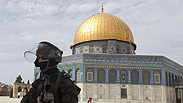
Jerusalem is today a 'bi-national city,' as nearly 40% of its residents are Palestinian
צילום: AFP
If we don’t divide Jerusalem, we'll lose it
Op-ed: Within a decade, Jerusalem will have a Palestinian majority. In the next elections, the city may already have a Palestinian mayor.
There are three national targets which all Israeli governments have been trying to achieve in Jerusalem since 1967: Demographic, territorial and political. The national effort has failed and the targets have not been achieved.
Not only has Israel failed to achieve its goal of reaching a Jewish majority of 80% and even 90%, as it mentioned in its demographic targets in the past in order for it to become a "uni-national city," but the opposite has happened: Jerusalem is today a "bi-national city," as nearly 40% of its residents are Palestinian.
The second target was territorial: The declared goal was and still is to take over, by building Jewish neighborhoods, the area of some 70 square kilometers (about 17,000 acres) which makes up the eastern part of the city, thereby disconnecting it from the Arab metropolis. This goal was not achieved either: Jewish neighborhoods are spread out today only on one-third of east Jerusalem. Two-thirds of the area have a Palestinian population which is the majority on the ground. From an urban perspective and political perspective, these neighborhoods connect to Bethlehem in the south and Ramallah in the north.
The third target was political: Gaining international legitimization on the one hand and the Palestinian residents' legitimization on the other hand for Israel's rule in east Jerusalem. After more than 40 years of diplomatic efforts, here too the outcome is disappointing: Not a single country among UN members has recognized our sovereignty in the eastern part of the city. The strongest objection to the Israeli acts of sovereignty in east Jerusalem is being led, of all countries, by our friend the United States, which has declared that it views construction in the eastern part of the city as an act of "illegal settlement."
Israel's governments have adopted a policy of "Israelization" towards the Palestinian residents, aspiring to turn them into "Israeli Arabs." The Palestinians outsmarted them and refused to be defined as such alongside the great benefit from the Israeli identity cards, which grant them economic perks (health services, national security and employment options which their brothers in the territories don't have). They are loyal to the Palestinian Authority institutions, and only some 10,000 residents of 300,000 have chosen to accept an Israeli nationality.
The result of the failure to meet the targets is deepening gaps between the two parts of the city and political polarization. While in the past a very small minority was ready to divide Jerusalem in exchange for peace, today their number among the Israeli public is rising. While until 2000 there was not a single government willing to so, since then we have had two prime ministers – Barak and Olmert – who expressed unequivocal support for the idea. Even in the current government concerns are rising over what will happen to Israel's capital if we fail to divide it in a peace agreement.
What are the expected scenarios?
Let's start with the economic area: Since 1967, Israel has invested some $20 billion in east Jerusalem in the construction of neighborhoods instead of investing it in west Jerusalem in growth-generating infrastructures, mainly in industry and tourism. In the past two decades some 200,000 Jews from the upper socioeconomic class have abandoned the city. Jerusalem has become the poorest city in Israel. The ongoing growth rate of the city's Palestinian and ultra-Orthodox populations will lead to its economic collapse.
The demographic processes are leading to a decrease in the Zionist-political center (the Labor and Likud parties) and strengthening the margins. The haredi community is not hiding its goal to turn Jerusalem into a "holy city" free of the influence of secular Israel. The ongoing growth of the haredi community (from 20% a decade ago to some 30% today) will take Israel 100 years back to the period when the city was anti-Zionist. The leaders of the Zionist Movement had considered giving up on Jerusalem as a capital and even – you're not going to believe this – searched for a capital elsewhere.
The political scenario is the most difficult: The annual Palestinian growth rate is 3.5% today, compared to a growth rate of only 1.5% among the Jewish residents. Within 10 years, Jerusalem will have a Palestinian majority. In fact, in as early as the next elections they will have the possibility of becoming the ruling party in Jerusalem and crowning a mayor of their own. An organized vote will give them a majority in the city council, and a Palestinian mayor will anyway be elected.
The scenarios I have described are shared by most researchers and experts on Jerusalem affairs. Our conclusion, which has become even stronger, was: Without dividing Jerusalem – we are about to lose it!
Prof. Moshe Amirav is a public policy lecturer at the Institute of Urban and Regional Studies at the Hebrew University in Jerusalem. He served as a member of the Jerusalem Municipality management alongside then-Mayor Teddy Kollek, and served as the head of former Prime Minister Ehud Barak's professional committee on Jerusalem issues during the Camp David negotiations.










